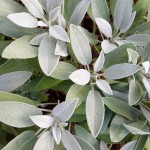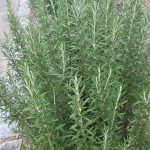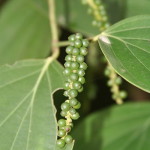You’re probably already growing most of the ingredients for poultry seasoning in your herb garden. When you are drying your herbs in the fall, put these aside to make your herb mix for that all important Thanksgiving meal. Here’s what you’ll need:
Sage (Salvia officinalis) is a woody sub-shrub native to the Mediterranean area and hardy in zones 5 through 9. It prefers full sun, getting a little leggy in partial shade. Plant it in well-drained soil and don’t over water. Sage is a drought tolerant plant who loves being a little dry. Full grown plants are 2’ to 3’ high. If you don’t have space for a large plant, consider Berggarten sage. It has broader leaves but tastes the same and only grows to 18”.
Thyme (Thymus vulgaris) is another Mediterranean native. A small shrubby perennial, it is hardy through zone 5. Mature plants range in size from 6 to 12 inches, depending on the variety. Thyme prefers a sunny location, but it can tolerate a little shade. What it can’t tolerate is over watering. Thymes are drought tolerant plants. Note that there are two types of thyme, upright and creeping thyme. The upright thymes are most often used in cooking.
Sweet Marjoram (Origanum majorana) is native to Cyprus and southern Turkey and a member of the oregano family with a milder, sweeter flavor than oregano. It is a tender perennial hardy only through zone 7. North of zone 7, it is usually grown as an annual or it can be brought indoors provided it has enough light. Supplemental lighting is recommended. Mature plants reach a height of 1 to 2 feet. Marjoram is happiest in full sun and dry soil.
Rosemary (Rosmarinus officinalis) native to the Mediterranean area, rosemary is a woody perennial that is reliably hardy through zone 7. It can survive mild winters with protection in zone 6. In northern areas, rosemary should be grown in containers and brought indoors once the outdoor temperatures falls below 30°F. Mature plants grown outside can reach a height of 5 feet. In warmer areas, it is often used as an ornamental shrub because it can be pruned into hedges and topiary. Provide your rosemary with full sun and don’t overwater. It likes to be dry. Indoors, you will need to provide supplemental lighting.
Nutmeg (Myristica fragrans) is the seed of a tropical tree native to Indonesia. The covering of the seed is the spice, mace. Nutmeg trees are also grown in India and the Caribbean. Harvest begins 7 to 9 years after the trees are planted but the trees don’t fully mature until after 20 years. Unlike bay laurel, nutmeg trees cannot be grown in containers so you will need to buy the whole seeds and grind them yourself or you can buy ground nutmeg at any grocery store.
Black Pepper (Piper nigrum) is the seed of the pepper vine, not to be confused with the familiar pepper plants which produce bell and jalapeno peppers (Capsicum annuum). The pepper vine is native to India and only hardy in zones 11b through 12. Outside of those zones, pepper vines are normally grown in containers and either brought indoors in chilly weather or grown entirely indoors. They like very hot and humid conditions. You will need to mist them daily indoors to provide humidity. The vines can grow as long as 12’ to 15’ so you will need to provide an adequate trellis. The seeds can be harvested when they are red. The seeds are dried before use. When they are blackened and wrinkled, they are full dry and ready to be ground.
Drying your herbs
Herbs can be dried in a number of ways. The traditional way is to tie bunches together and hang them upside down until dried. They can also be dried in a single layer on a screen propped between 2 sawhorses or straightback chairs. For faster results, herbs can be dried in your oven (2 to 3 hours at 110⁰F), microwave (1 to 2 minutes on high) or food dehydrator.
Grinding your herbs
The traditional way to grind herbs is using mortar and pestle. This takes time and elbow grease. It’s also a great way to “perfume” your kitchen. A coffee grinder is a great option if you are pressed for time or are troubled by arthritis making it difficult to use a mortar and pestle. Just be sure to thoroughly clean it after using it grind herbs so that your coffee doesn’t taste of herbs. A micro-plane, also called a zester, can be used for whole nutmegs.
Poultry Seasoning Recipe
Once your herbs are all ground, combine them as follows:
- 2 teaspoons ground sage
- 1 ½ teaspoons ground thyme
- 1 teaspoon ground marjoram
- ¾ teaspoon ground rosemary
- ½ teaspoon ground nutmeg
- ½ teaspoon ground black pepper
Store your poultry seasoning mix in a tightly covered glass jar in a cool, dry place with no sunlight. Heat, moisture and light can all rob your herbs of their flavor.
More Herb Blends
Bouquet Garni
Chinese Five Spice Blend
Curry Blend
Fines Herbes
Herbes de Provence
Italian Seasoning
Old Bay Seasoning
Paprika
Za’atar







